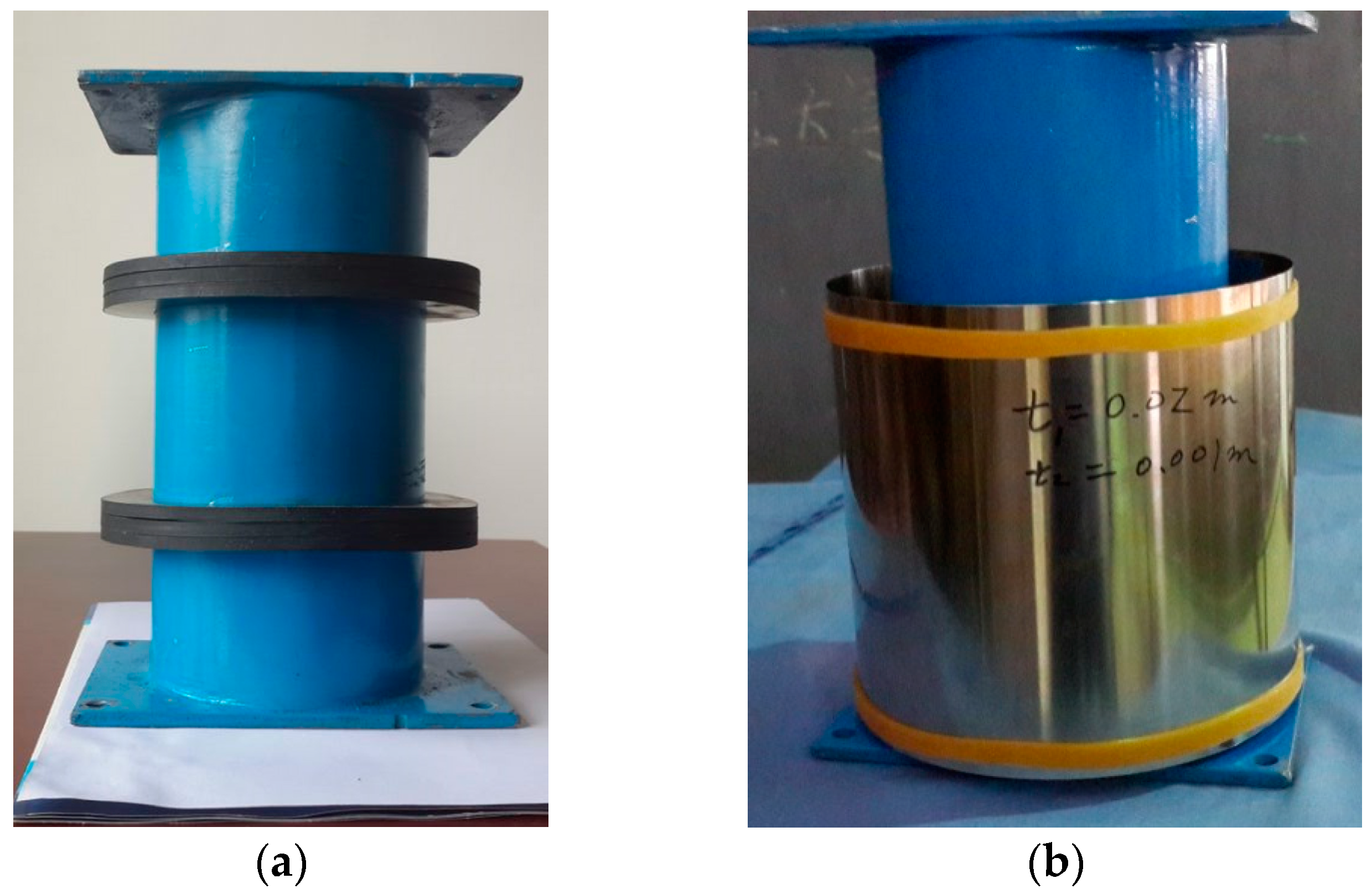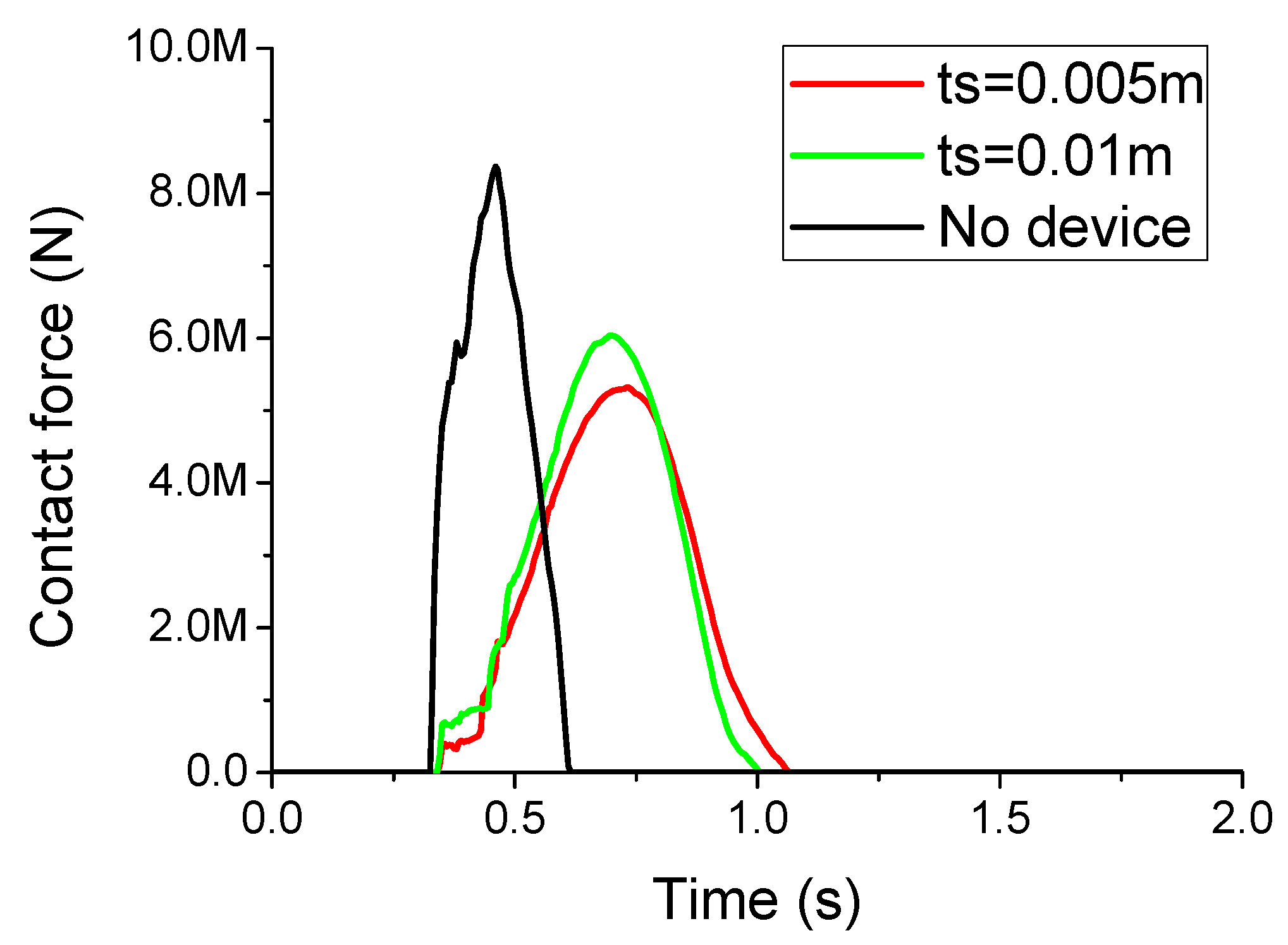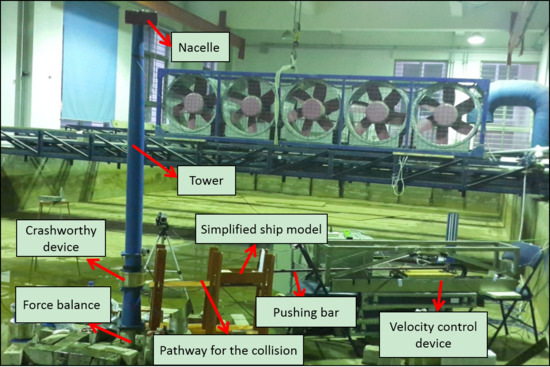Experimental Study on the Performance of a Crashworthy Device for the Monopile Offshore Wind Turbine against Ship Impact
Abstract
:1. Introduction
2. Project Background
3. Ship-OWT Impact Model Test Setup
3.1. Overview of the Ship-OWT Impact System
3.2. Simplified Ship Model
3.3. Crashworthy Device
4. Results and Discussion
4.1. Effect of Different Rubber Radial Thicknesses of the Crashworthy Device
4.2. Effect of Different Steel Shell Thickness of the Crashworthy Device
4.3. Effect of Different Impact Energy
4.4. Effect of the Porous Design for the Outer Steel Shell
5. Conclusions
6. Future Work
Author Contributions
Funding
Conflicts of Interest
References
- Su, X. The statistics and analysis of the global offshore wind power development in 2012. Wind Energy 2013, 6, 30–35. [Google Scholar]
- Dai, L.; Ehlers, S.; Rausand, M.; Utne, I.B. Risk of collision between service vessels and offshore wind turbines. Reliab. Eng. Syst. Saf. 2013, 109, 18–31. [Google Scholar] [CrossRef]
- Biehl, F. Ship collisions and offshore wind energy turbines: Calculation and Evaluation. In Proceedings of the Scientific Forum of the Federal Ministry for the Environment, Nature Conservation and Nuclear Safety (BMU) on Offshore Wind Energy, Utilisation, Berlin, Germany, 15–18 June 2004. [Google Scholar]
- Kremser, E. Risk assessment and precautionary measures for offshore wind parks. In Proceedings of the Scientific Forum of the Federal Ministry for the Environment, Nature Conservation and Nuclear Safety (BMU) on Offshore Wind Energy, Utilisation, Berlin, Germany, 15–18 June 2004. [Google Scholar]
- Bontempi, F.; Li, H.; Petrini, F.; Manenti, S. Numerical modeling for the analysis and design of offshore wind turbines. In Proceedings of the 4th International Conference on Advances in Structural Engineering and Mechanics (ASEM’08), Jeju, Korea, 26–28 May 2008. [Google Scholar]
- International Electrotechnical Commission. IEC 61400-3 Wind Turbines—Part 3: Design Requirements for Offshore Wind Turbines; IEC: Geneva, Switzerland, 2009. [Google Scholar]
- Det Norske Veritas. DNV-OS-J101 Offshore Standard. Design of Offshore Wind Turbine Structures; Det Norske Veritas: Oslo, Norway, 2014. [Google Scholar]
- Hao, E.T.; Liu, C.G. Evaluation and comparison of anti-impact performance to offshore wind turbine foundations: Monopile, tripod, and jacket. Ocean Eng. 2017, 130, 218–227. [Google Scholar] [CrossRef]
- Bela, A.; Sourne, H.L.; Buldgen, L.; Tigo, P. Ship collision analysis on offshore wind turbine monopile foundations. Mar. Struct. 2017, 51, 220–241. [Google Scholar] [CrossRef]
- Ren, N.X.; Ou, J.P. Dynamic numerical simulation for ship-OWT collision. In Proceedings of the 8th International Conference on Reliability, Maintainability and Safety, Chengdu, China, 20–24 July 2009; pp. 1003–1007. [Google Scholar]
- Ren, N.X.; Ou, J.P. A crashworthy device against ship–OWT collision and its protection effects on the tower of offshore wind farms. China Ocean Eng. 2009, 23, 593–602. [Google Scholar]
- Graczykowski, C.; Holnicki-Szulc, J. Protecting offshore wind turbines against ship impacts by means of adaptive inflatable structures. Shock Vib. 2009, 16, 335–353. [Google Scholar] [CrossRef]
- Hao, E.T.; Liu, Y.Z.; Liu, C.G. Numerical simulation of monopile foundation of an offshore wind turbine subjected to ship impact. J. Vib. Shock 2015, 3, 7–13. [Google Scholar]
- Liu, C.G.; Hao, E.T.; Zhang, S.B. Optimization and application of a crashworthy device for the monopile offshore wind turbine against ship impact. Appl. Ocean Res. 2015, 51, 129–137. [Google Scholar] [CrossRef]
- Ding, H.Y.; Zhu, Q.; Zhang, P.Y. Dynamic simulation on collision between ship and offshore wind turbine. Trans. Tianjin Univ. 2014, 20, 1–6. [Google Scholar] [CrossRef]
- Lee, K. Effects on the various rubber fenders of a tripod offshore wind turbine substructure collision strength due to boat. Ocean Eng. 2013, 72, 188–194. [Google Scholar] [CrossRef]
- Zhang, J.H.; Gao, D.W.; Sun, K.; Zhang, Z. Ship impact behavior on jacket type offshore wind turbine foundation. In Proceedings of the 33rd International Conference on Ocean, Offshore and Arctic Engineering, San Francisco, CA, USA, 8–13 June 2014. [Google Scholar]
- Moulas, D.; Shafiee, M.; Mehmanparast, A. Damage analysis of ship collisions with offshore wind turbine foundations. Ocean Eng. 2017, 143, 149–162. [Google Scholar] [CrossRef]
- Lehmann, E.; Peschmann, J. Energy absorption by the steel structure of ships in the event of collisions. Mar. Struct. 2002, 15, 429–441. [Google Scholar] [CrossRef]
- Det Norske Veritas. Offshore Standard DNV-OS-A101, Safety Principals and Arrangements; Det Norske Veritas: Oslo, Norway, 2013. [Google Scholar]
- Ren, N.X.; Ma, Z.; Fan, T.H.; Zhai, G.J.; Ou, J.P. Experimental and numerical study of hydrodynamic responses of a new combined monopile wind turbine and a heave-type wave energy converter under typical operational conditions. Ocean Eng. 2018, 159, 1–8. [Google Scholar] [CrossRef]
- Shan, B.H.; Zheng, S.J.; Ou, J.P. A stereovision-based crack width detection approach for concrete surface assessment. KSCE J. Civ. Eng. 2016, 20, 803–812. [Google Scholar] [CrossRef]







| Parameters | Full Model | Scale Model (1:50) |
|---|---|---|
| Wind turbine | 4 MW | ------ |
| Water depth (m) | 15 | 0.3 |
| Nacelle and blades (kg) | 250,000 | 2.0 |
| Tower height (m) | 87.5 | 1.75 |
| Tower above MWL (m) | D1 = 3.5~5.5 t1 = 0.025~0.075 | D1 = 0.07~0.11 t1 = 0.0005~0.0015 |
| Tower below MWL (m) | D2 = 5.5~7.0 t2 = 0.075 | D2 = 0.11~0.14 t2 = 0.0015 |
| Ship model | ||
| Ship mass (kg) | 500,000~2,000,000 | 4~16 |
| impact velocity (m/s) | 1.0~2.0 | 0.14~0.28 |
| Crashworthy device | ||
| Rubber torus (m) | tr = 0.5~1.5; hr = 1.0 | tr = 0.01~0.03 hr = 0.02 |
| Steel shell (m) | ts = 0.005~0.010 hs = 5.0 | ts = 0.0001~0.0002 hs = 0.1 |
| Crashworthy Device | tr (m) | Impact Force (MN) | Ratio * | Acceleration (m/s2) | Ratio * | Bending Moment (MNm) | Ratio * |
|---|---|---|---|---|---|---|---|
| No | ----- | 8.36 | 100% | 5.58 | 100% | 70.53 | 100% |
| Yes | 0.5 | 6.20 | 74% | 2.35 | 42% | 47.40 | 67% |
| Yes | 1.0 | 5.30 | 64% | 1.80 | 32% | 42.30 | 60% |
| Yes | 1.5 | 5.00 | 60% | 1.70 | 30% | 40.60 | 58% |
| Crashworthy Device | ts (mm) | Impact Force (MN) | Ratio * | Acceleration (m/s2) | Ratio * | Bending Moment (MNm) | Ratio * |
|---|---|---|---|---|---|---|---|
| No | ----- | 8.36 | 100% | 5.58 | 100% | 70.53 | 100% |
| Yes | 5.0 | 5.35 | 64% | 1.80 | 32% | 42.30 | 60% |
| Yes | 10.0 | 6.00 | 72% | 2.00 | 36% | 47.40 | 67% |
| Case No. | Impact Information | Crashworthy Device | Impact F (MN) | Ratio * | Acceleration (m/s2) | Ratio * | Bending M (MNm) | Ratio * |
|---|---|---|---|---|---|---|---|---|
| 1 | 500 t | No | 5.82 | 100% | 5.31 | 100% | 38.85 | 100% |
| V = 1 m/s | Yes | 3.00 | 52% | 1.60 | 30% | 18.65 | 48% | |
| 2 | 500 t | No | 8.30 | 100% | 6.89 | 100% | 69.50 | 100% |
| V = 2 m/s | Yes | 6.65 | 80% | 3.15 | 46% | 51.70 | 74% | |
| 3 | 2000 t | No | 8.36 | 100% | 5.58 | 100% | 70.53 | 100% |
| V = 1 m/s | Yes | 5.30 | 64% | 1.80 | 32% | 42.30 | 60% | |
| 4 | 2000 t | No | 11.55 | 100% | 7.30 | 100% | 157.50 | 100% |
| V = 2 m/s | Yes | 10.40 | 90% | 3.05 | 42% | 135.45 | 86% |
| Case No. | Impact Information | Device with Porous | Impact F (MN) | Ratio * | Acceleration (m/s2) | Ratio * |
|---|---|---|---|---|---|---|
| 1 | 500 t | No | 3.00 | 52% | 1.60 | 30% |
| V = 1 m/s | Yes | 2.80 | 48% | 1.40 | 26% | |
| 2 | 500 t | No | 6.67 | 80% | 2.64 | 38% |
| V = 2 m/s | Yes | 6.45 | 78% | 2.40 | 35% | |
| 4 | 2000 t | No | 10.40 | 90% | 3.05 | 42% |
| V = 2 m/s | Yes | 10.05 | 87% | 2.90 | 40% |
© 2018 by the authors. Licensee MDPI, Basel, Switzerland. This article is an open access article distributed under the terms and conditions of the Creative Commons Attribution (CC BY) license (http://creativecommons.org/licenses/by/4.0/).
Share and Cite
Ren, N.; Li, W.; Ma, Z.; Ou, J.; Ning, D. Experimental Study on the Performance of a Crashworthy Device for the Monopile Offshore Wind Turbine against Ship Impact. Energies 2018, 11, 3173. https://doi.org/10.3390/en11113173
Ren N, Li W, Ma Z, Ou J, Ning D. Experimental Study on the Performance of a Crashworthy Device for the Monopile Offshore Wind Turbine against Ship Impact. Energies. 2018; 11(11):3173. https://doi.org/10.3390/en11113173
Chicago/Turabian StyleRen, Nianxin, Wei Li, Zhe Ma, Jinping Ou, and Dezhi Ning. 2018. "Experimental Study on the Performance of a Crashworthy Device for the Monopile Offshore Wind Turbine against Ship Impact" Energies 11, no. 11: 3173. https://doi.org/10.3390/en11113173






